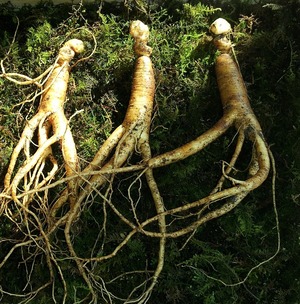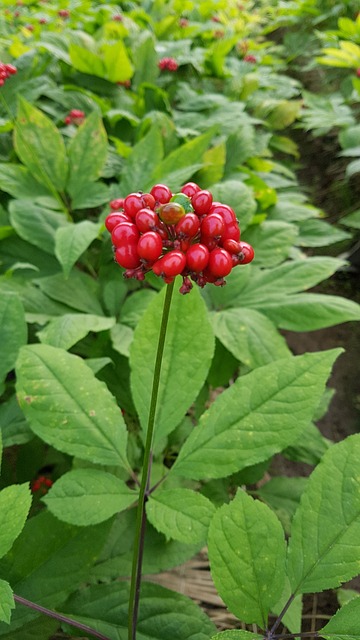Panax ginseng

This is about the effects of Panax ginseng for health including hormone balance.
Etymology
Panax ginseng goes by the name of Korean ginseng. Chinese ginseng is a name for Panax ginseng and Panax notoginseng.
Panax belongs to the Araliaceae family.
Properties

Panax ginseng upregulates AR (androgen receptor), ERα (estrogen receptor alpha) and ERβ (estrogen receptor beta). It has been documented to increase bodily estrogen and ovarian weight, but this appears to be circumstantial.
Other species of Panax are known for female health use, but their specific properties on receptors are less documented.
Anecdotal evidence
When taken when there are low signs of bodily estrogens, Panax ginseng increases negative responses such as body hair and hot-flashes. Panax ginseng's ability to increase estrogen response depends on when during the cycle it is used. Its ability to increase ovarian function, and likely ovarian weight, is associated with during the menstrual cycle when estrogen levels are normally high.
Use
Panax for breast enhancement
Ginseng's effects are circumstantial. If ginseng is useful for breast enhancement, the only time it could possibly be used is during mid secretory phase, when both estrogen and progesterone levels are high. In cases of hormone imbalance or low body weight, there is a smaller window of time during the menstrual cycle when ginseng and similar herbs can potentially be used for preferable results.
Wait until the next day before determining its full effects.
Because ginseng upregulates AR, it behaves differently than other herbs that also upregulate ERα or ERβ.
Panax or herbs with similar properties are in herb programs based on menstrual phases. There must be balance throughout phases, and combinations of herbs help the body acheive balance for health, breast growth and hip growth. It's important that menses is light and short. Also, preventing an excess of negative symptoms for menses helps set the balance for proliferative phase. Luteal phase uses a different combination of herbs than proliferative phase for symptoms. For a simplified herb schedule, where there's commonality of herb recommendations for symptoms such as swelling and signs of excess estrogen, use nonmenses. BCP01 is a composite page of pieces of different programs on birth control or IUD use.
Herb timing and combinations' success for breast enhancement relies on menstrual phases. Descriptions and pictures of results from herb combination use can be seen in programs. For more guidance, see guide, or hirsutism-topic.
For hormone balance
Despite ginseng's reputation as an adaptogen, ginseng appears to have the opposite effect for women especially during menses and premenstrual phases. It conditionally increases androgenic effects, or when it increases estrogenic effects, it often causes headaches.
Similar herbs
Sunflower seed is a better and proven substitute than ginseng. Sunflower works more consistently than lavender for improving hormone balance, but both require estrogenic and progestogenic conditions of the body. Minimal amounts of fenugreek or likely asparagus assist in providing temporary estrogenic and progestogenic balance.
For an adaptogen: use maca instead.
Schizandra chinensis and Salvia miltiorrhiza have similar properties to Panax ginseng.
The adaptogen Schizandra chinensis upregulates ERα and ERβ. A study found it to increase estrogen production, but this is circumstantial.
Salvia miltiorrhiza is known as Danshen, red sage and Chinese sage. Danshen increases sensitization of ERα and ERβ. According to studies, Chinese sage increases the weight of ovaries and levels of estrogen, but this may be circumstantial depending on when during the menstrual cycle it is taken.
The researchers who studied Chinese sage concluded that, common sage (Salvia officinalis) diminishes ovarian cells. In small amounts, common sage had an insignificant effect on reducing ovarian function. Their study found Salvia officinalis to improve symptoms of hot-flashes. Common sage is not expected to promote breast growth. Salvia officinalis and other species of sage are unsuitable for use in a herbal bust enhancement program.
Effects on the ovaries by Panax ginseng, schizandra, sages and other estrogen receptor upregulating herbs may be circumstantial, depending on whether they are taken during mid proliferative phase, the amount that is taken, hormone levels, and whether they are taken in the presence of other herbs. Whether these herbs behave as their reputation suggests as androgenic or estrogenic is circumstantial.
Precautions
Despite being an adaptogen, avoid ginseng for menstruation, early proliferative phase and late premenstrual phase as this may cause or increase unfavorable symptoms. Limit use of Panax ginseng to less than 200mg of solid herb per day. In cases of trying to correct hormone imbalances, use minimal amounts of Korean ginseng. For similar herbs, do not take more than 125mg of solid herb per day.
See precautions for more details of care to be taken with herb use. Proper nutrition is a consideration for health. Also, check for the latest blog updates about herb and hormone safety.
It is very important that menses be light and not prolonged.
If you have hirsutism, PCOS, hot-flashes, other signs of hormone imbalances, see estrogen-imbalance, and hirsutism program journals at hirusitism-topic before trying herbs.
Herb concentrates can be tens of times more potent by weight than herbs in solid form. This can easily lead to hormone imbalances. For this reason, concentrate extracts are not recommended for extended or excessive internal use, especially during fertility years. Concentrates shouldn't be used to overcome plateaus. Another issue with herbal extracts, is that they may not have the full range of properties of the herb. Essential oils are not recommended for breast enhancement. If opting to use herbal extracts, use food grade extracts, with no more than 1 drop at a time diluted in water.
More


For the latest herb programs and how to get started, see: guide. Pictures of breast enhancement can be seen in the program journals of Anon02, Anon08, Anon09, Bubblemelon and Jellie.
For resources on hips and butt enhancement, see: /appendix/hips-butt-enhancement and /appendix/kettlebell.
breast-endocrinology.pdf describes the science of breast development and endocrinology. It also describes symptoms related to hormone imbalances. Biology and hormone imbalances are excerpts from this ebook. breast-endocrinology.pdf uses a Creative Commons (CC BY-ND 4.0) license.
Breast.is blog
References:
- Treatment with Panax Ginseng Antagonizes the Estrogen Decline in Ovariectomized Mice. https://www.ncbi.nlm.nih.gov/pmc/articles/PMC4057706/.
- Effects of ginseng on two main sex steroid hormone receptors: estrogen and androgen receptors. https://www.ncbi.nlm.nih.gov/pmc/articles/PMC5386121/.
- Estrogenic effect of the extract of Renshen (Radix Ginseng) on reproductive tissues in immature mice. https://www.ncbi.nlm.nih.gov/pubmed/26427118.
Etymology & Definitions:
- USDA Plant profile: Panax ginseng. https://plants.usda.gov/core/profile?symbol=PAGI2.
- ITIS Report: Panax. https://www.itis.gov/servlet/SingleRpt/SingleRpt?search_topic=TSN&search_value=29398#null.
Resources:
- Schizandra chinensis exhibits phytoestrogenic effects by regulating the activation of estrogen receptor-α and -β. https://www.ncbi.nlm.nih.gov/pubmed/28762131.
- Ameliorative effects of Schizandra chinensis on osteoporosis via activation of estrogen receptor (ER)-α/-β. https://www.ncbi.nlm.nih.gov/pubmed/24881676.
- Salvia miltiorrhiza bunge increases estrogen level without side effects on reproductive tissues in immature/ovariectomized mice. https://www.ncbi.nlm.nih.gov/pubmed/27997360.
- First time proof of sage's tolerability and efficacy in menopausal women with hot flushes.. https://www.ncbi.nlm.nih.gov/pubmed/21630133.
- The effects of Salvia officinalis L. on granulosa cells and in vitro maturation of oocytes in mice. https://www.ncbi.nlm.nih.gov/pmc/articles/PMC5767646/.
- Salvia officinalis L. induces alveolar bud growing in adult female rat mammary glands. https://www.ncbi.nlm.nih.gov/pmc/articles/PMC4678501/.
- Ovarian protection in cyclophosphamide-treated mice by fennel. https://www.ncbi.nlm.nih.gov/pmc/articles/PMC5615121/.
- The effect of fennel (Foeniculum vulgare) gel 3% in decreasing hair thickness in idiopathic mild to moderate hirsutism, A randomized placebo controlled clinical trial. https://www.ncbi.nlm.nih.gov/pmc/articles/PMC3894467/.
